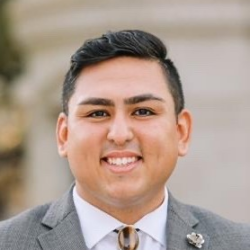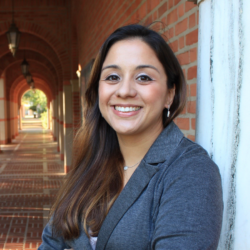As part of TNTP’s celebration of Multilingual Learner (ML) Advocacy Month, we want to shine a light on what actions Ednovate, a network of six high schools in Southern California, is taking to prioritize support for Multilingual Learners. Multilingual Learners are one of the fastest-growing populations in K-12 schools nationwide, and, with already limited resources and staff, many schools have room to grow to leverage their assets and meet their needs. As more ML students join school communities, it’s imperative that they have personalized systems of support from educators and leaders who value their unique assets and linguistic identities. When students have support to meet their individual needs, they’re better equipped to build the strong academic foundation they need for future success.
Through an analysis of student data disaggregated by demographic group, Ednovate identified that ML academic performance was below that of their non-ML peers. In response, the network prioritized multilingual learners in their annual strategic plan, leveraging the federal funding they receive for MLs to support their efforts. Ednovate then took the following steps to put their vision into action:
1. Focus on the student experience
Ednovate and TNTP started by observing classrooms to better understand what students experienced during instruction, and determined that both teachers and ML students needed targeted support to make the most of classroom learning time. They then established two layers of support:
- Ednovate hired a team of ML Tutors, who receive additional training on the linguistic needs of multilingual students, to collaborate with teachers and strategically ‘push in’ to classrooms to deliver one-on-one support to MLs focused on their specific language needs.
- The network implemented a professional learning series on best practices for teaching MLs. In collaboration with TNTP, APs of Instruction co-observed teachers and provided actionable feedback as they applied new strategies to support students’ language development, while simultaneously growing content knowledge.
2. Build sustainable structures for support and collaboration
From an administrative standpoint, supporting MLs requires close attention to a wide range of interrelated responsibilities, from state and federal compliance tasks and language assessments to planning professional development to analyzing data and beyond. To streamline this process and support sustainability, Ednovate leaders:
- Established the role of ML Coordinator to lead support efforts at each campus, recruiting in part from their pool of ML Tutors.
- Invested in a dedicated English Language Development curriculum to provide students with specific language development instruction during designated ELD, and an online portal to help manage required ML student data and documentation.
- Carved out time for the team of ML Coordinators and ML Tutors to meet bi-weekly for 90 minutes of professional learning and collaboration that helps them continue to improve the language support they provide.
3. Break ML supports out of siloes
Ednovate leaders intentionally built connections among educators in different departments and across their six campuses to ensure that the new ML support efforts stayed consistent, equitable, and aligned to network and campus priorities.
- Network leaders ensured that ML Coordinators collaborated with Special Education staff to explore ways to meet the needs of MLs with Individualized Education Plans (IEPs).
- Content leaders collaborated with ML specialists to work through the unique language development demands of different content areas, such as math.
- ML Coordinators for each campus collaborated with APs of Instruction to ensure the content and messages of professional development sessions aligned to the school’s priorities.
4. Engage families and caregivers
When building a personalized system of support for MLs, families and caregivers are essential partners. Beyond the state required meetings and communication with ML families, Ednovate created opportunities for ML families to connect, build community, and learn, including both in-person and virtual meetings at the school and network level.
5. Commit to continuous improvement
Changing school systems’ structures and practices for supporting MLs takes intentionality, investment, and self-reflection, all of which Ednovate has modeled throughout our partnership. Thanks to Ednovate’s efforts, educators are already seeing a positive impact from these changes:
“Being able to work with Jackson, our ML Tutor, and Escobar, our ML Coordinator, has completely changed my instruction and expectation for MLs. With their support, MLs in my class were able to produce a full page of mathematical writing in English about the grade-level standards.” — Liz Vaughan, 11th Grade Math Instructor, Brio College Prep
Looking ahead, TNTP will continue to help Ednovate build on this strong foundation, analyzing data and student work to monitor their progress and impact.
Multilingual students bring a wealth of knowledge, skills, culture, and languages to school with them each day. With personalized systems of support that factor in their needs, assets, and aspirations, MLs can build a strong academic foundation that prepares them for thriving lives and careers of their choosing. If your school system is ready to improve its support for multilingual students, contact us today.








